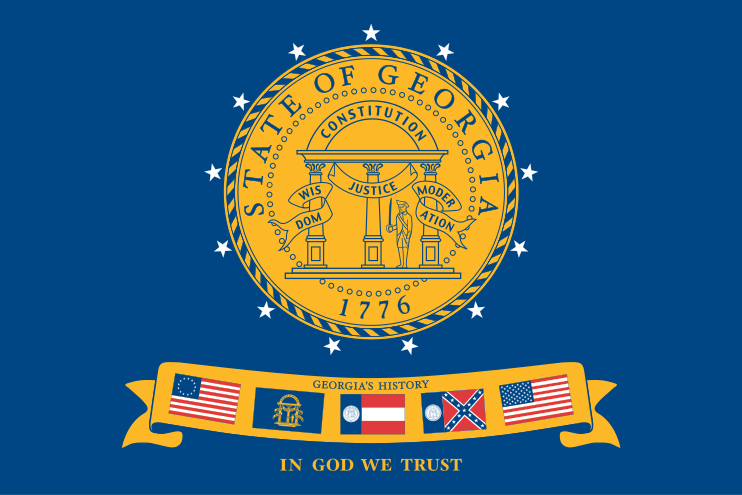The Weekender, January 15, 2021
Hi!
Before I get started today, a quick note: I’m taking Monday off in observance of Dr. Martin Luther King, Jr.’s birthday. Maybe I’ll run an MLK-themed re-run, dunno.
Anyway, let’s talk about flag design. Flag design is a really weird thing because people spend a lot of time and effort designing flags, and yet, there are a lot of really bad ones out there. I don’t mean offensive flags, either. I just mean plain old ugly ones. Take, for example, the plight of Georgia. Their flag, here, was adopted in 1956 and had the state seal on the left and the Confederate battle insignia on the right. Over time, more and more people objected, and finally, Georgia agreed to redo its flag. But they kind of split the baby, so to speak, and tried to incorporate the old flag into the new one. The result was this monstrosity.

I mean, that’s horrible. (And it still had the Confederate flag on it!)
Thankfully, the flag only lasted two years; Georgia’s flag now looks like this. Much better.
In any event, this shouldn’t be a big undertaking to get right. As I mentioned on Wednesday (in the little blurb at the top of the email), the city of Galveston, Texas is redesigning its flag; you can vote for your favorite here, (My top three choices, in order, were E, B, and J) If you go to that page, you’ll see a link to an organization called the North American Vexillological Association, which describes itself as “an international, non-profit, scholarly organization dedicated to vexillology, the study of flags and their cultural, historical, political, and social significance.” (There’s an organization for almost everything, I guess.) And NAVA has put a lot of thought into what makes for a good flag. A lot of thought. The basics of good flag design, per NAVA, are on that Galveston page, but if that’s not enough for you, NAVA also has an 8-page pdf explaining each of the five factors listed on that page.
And yet, there are a ton of flags that just don’t follow these rules. I’m not the expert on that, though — Roman Mars, of the design podcast 99 Percent Invisible, is the guy you want to listen to. In 2005, he gave a TED Talk about flag design. It’s 18 minutes, brilliant, funny, and ends with the worst flag you’ll ever see (one hopes). Give that a watch; it’s well worth your time if your reaction to that Georgia flag was “wait, what?”
Want more? In 2004, NAVA put together a ranked list of 150 city flag designs; you can see that pdf here.
The Now I Know Week in Review
Monday: How Postage May Have Saved the Panama Canal: That and volcanos.
Tuesday: A Bridge With Some Firepower: Somewhere, I’m sure, there’s a video of this happening. I couldn’t find it, though.
Wednesday: The Blessing of Overpriced Orange Juice: It amuses me that he doesn’t end up with orange juice. I mean, not immediately at least. I’m sure he can buy some whenever he wants now.
Thursday: lɐɯɹou ƃuᴉʞool ʇnq uʍop ǝpᴉsdn: Fun meta-fact: I had to change the title on the archived version because, when I updated the website to clear out some malware, the titles became all caps. And the capital-letter version of “lɐɯɹou ƃuᴉʞool ʇnq uʍop ǝpᴉsdn” looked neither normal nor upside-down. (The new one isn’t so great looking either, to be honest.)
For those who wanted to know how I generated the title, I used an online upside-down text generator.
And some other things you should check out:
Some long reads for the weekend.
1) “How New York City Vaccinated 6 Million People in Less Than a Month” (New York Times, 9 minutes, December 2020). Smallpox, not coronavirus.
2) “The true story of the fake US embassy in Ghana” (The Guardian, 19 minutes, November 2017). This was something I was going to write about — and I’m glad I didn’t, because my knowledge of it, it turns out, was incomplete. As the story says, “the fake embassy became a sensation largely because the story was so predictably familiar. The Africans were scammers. The victims were desperate and credulous. The local police officers were bumbling idiots. Countless officials were paid off. And at the end, the Americans swooped in and saved the day. There was only one problem with the story: it wasn’t true.”
3) “How eBird Changed Birding Forever” (Outside Magazine, 12 minutes, December 2020.) This is overall very interesting, even if you’re not interested in birds, birdwatching, birding, etc. (I am not, personally, into it at all.) One favorite paragraph: “One eBird app reviewer, ‘Notta Realname,’ noted that after spotting an unusual bird for their locality, birders rang their doorbell, asking to sit in their backyard so they could see the bird. Notta Realname reported being ‘flummoxed’ but welcomed the birders into their backyard anyway and then became frustrated when the unexpected guests displayed ‘questionable’ ethics. Notta Realname turned away subsequent birders and then changed their privacy settings. All birders I know would agree: showing up at a stranger’s doorstep unannounced is bad form.”
Have a great weekend!
Dan
